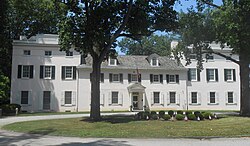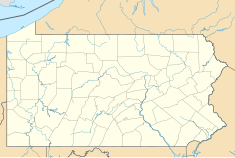Historic Strawberry Mansion
This article has multiple issues. Please help improve it or discuss these issues on the talk page. (Learn how and when to remove these messages)
|
| Strawberry Mansion | |
|---|---|
 Strawberry Mansion in 2014 | |
| Location | Philadelphia, Pennsylvania |
| Coordinates | 39°59′40″N 75°11′26″W / 39.99444°N 75.19056°W |
| Built | 1789 |
Historic Strawberry Mansion is a summer home originally built for Judge William Lewis[1] in 1789. It is located in East Fairmount Park, Philadelphia, Pennsylvania, USA.
The house was restored in 1926 by The Committee of 1926 for use as a historic house museum and place of hospitality.
William Lewis
William Lewis was born in 1751 in Edgmont, Pennsylvania to a Quaker family of Welsh ancestry. As a lawyer during revolutionary times, he consistently defended other Quakers against charges of treason after they refused to fight in battle or pay taxes. In doing so he participated in creating the foundations of Conscientious Objection.
Lewis was appointed to Federal Judicial positions by George Washington and also advised Alexander Hamilton on the first national bank. His most important achievement was his role in the drafting and passage of An Act for the Gradual Abolition of Slavery[2] in 1780. This legislation was the first legal action towards the abolition of slavery in the United States of America. Judge Lewis died peacefully at Strawberry Mansion, then called Summerville, at the age of 68.[3]
Joseph Hemphill
Joseph Hemphill was born in 1770 in Chester County, now Delaware County. He purchased Strawberry Mansion two years after Lewis's death in 1821. His family was responsible for adding the Greek Revival wings to the principal Federal style structure, erected by Lewis, ca. 1828. He served as a member of the House of Representatives, in addition to being a prominent lawyer and judge. Hemphill is, perhaps, more well known among antique collectors for his role in the limited manufacture of Hemphill and Tucker porcelain. His collaborative effort with Philadelphia porcelain maker William Ellis Tucker lasted only 6 years, from 1832 to 1838.
Property of Fairmount Park
In 1867 Strawberry Mansion was sold to the city by a landowner who had been in possession of it since Judge Hemphill's death in 1842. The purchase of the mansion, along with a great deal of the surrounding land, was part of an effort to protect the source of the city's drinking water, the Schuylkill River. The area came to be known as East Fairmount Park, under the supervision of the Fairmount Park Commission.
Renovations
In 1926 several women's clubs combined efforts with Mayor W. Freeland Kendrick to create a Sesquicentennial Exposition in South Philadelphia in honor of the 150th anniversary of the signing of the Declaration of Independence. Several women from the event did not want to disband, and instead sought an area to move many of the antique furniture collections to another location. Under the supervision of the Philadelphia Museum of Art and the Fairmount Park Commission, the new Committee of 1926 radically renovated Strawberry Mansion to be used as a museum space and "place of hospitality". Funds for the renovation were donated by Joseph Horn, of Horn and Hardart's Automats. Horn grew up in the Philadelphia area and was fond of playing in the park as a child. Decor and furnishings were the charge of various women's societies throughout the city who filled the rooms with exceptional period furnishings. The house officially reopened in 1931 with Mrs. J. Willis Martin (Elizabeth Price) as the first president of the Committee of 1926. Today the Committee of 1926 continues to preserve the historic house museum and the principles of hospitality on which it was founded.[4]
Strawberry Mansion was renovated again in the early 21st century.[5]
Tours
Historic Strawberry Mansion is open year-round, 10:00 am to 4:00 pm, Tuesday through Sunday.
See also
- Nannie Lee House aka Strawberry Mansion in Florida
- Strawberry Mansion (disambiguation)
- Strawberry Mansion Bridge
- Strawberry Mansion High School
- Strawberry Mansion, Philadelphia
References
- ^ "History of the Federal Judiciary". Fjc.gov. Retrieved 2016-02-11.
- ^ "Documents from 1776 - 1865". Portal.state.pa.us. Retrieved 2016-02-11.
- ^ Ashmeade, Henry Graham (1884). History of Delaware County, Pennsylvania (PDF). Philadelphia: L.H. Everts & Co. pp. 560–561. Retrieved 7 June 2017.
- ^ "Organization Report". Retrieved 11 February 2016.
- ^ Historic Strawberry Mansion. "The Restoration Project". Retrieved 11 February 2016.
External links
- Historic Strawberry Mansion Homepage
- Fairmount Park
- Philadelphia Museum of Art
- Park House Guides, PMA,
- Historic Photographs of Historic Strawberry Mansion, PhillyHistory.org
- Historic American Buildings Survey (HABS) No. PA-1668, "Strawberry Mansion", 24 photos, 1 color transparency, 8 data pages, 5 photo caption pages


